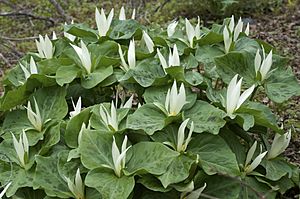Giant white wakerobin facts for kids
Quick facts for kids Giant white wakerobin |
|
|---|---|
 |
|
| Mendocino County, California | |
| Conservation status | |
| Scientific classification | |
| Genus: |
Trillium
|
| Species: |
albidum
|
| Synonyms | |
|
|
Trillium albidum, also known as giant white wakerobin, white toadshade, and sweet trillium, is a species of flowering plant in the family Melanthiaceae. The species is endemic to the western United States, ranging from west central California through Oregon to Washington. It is found in diverse habitats, on the moist slopes of mixed deciduous-coniferous forests, among shrubs and thickets, and along stream banks and river beds.
In his authoritative treatment of 1975, Freeman noted that Trillium albidum "has been treated under the misapplied epithet "chloropetalum" for more than half a century." In the area surrounding San Francisco Bay, where the ranges of T. albidum and T. chloropetalum overlap, identification is difficult. The intermediate populations in this region may be due to hybridization of the two species.
Taxonomy
In addition to Trillium albidum J.D.Freeman, the following infraspecific names are accepted by most naming authorities:
- Trillium albidum subsp. albidum
- Trillium albidum subsp. parviflorum (V.G.Soukup) K.L.Chambers & S.C.Meyers
The two subspecies are distinguished by overall size as well as the size and shape of the flower petals. In subsp. parviflorum, the scape is just 17 to 30 cm (6.5 to 12 in) high (which is half of subsp. albidum) while the petals are just 2.2 to 4.5 cm (1 to 2 in) long and 0.4 to 1 cm (0 to 0.5 in) wide (which is consistently shorter and narrower than those of subsp. albidum).
In 2002, Case described two distinct but related Trillium species, T. albidum J.D.Freeman and T. parviflorum V.G.Soukup. Some naming authorities still consider both of these species names to be valid while other authorities consider the latter name to be a synonym for T. albidum subsp. parviflorum, in which case the two species originally described by Case become a single species. In any case, there is evidence that T. albidum and T. albidum subsp. parviflorum are less closely related to each other than the latter is to T. luteum, a sessile trillium species native to eastern North America.
Geographically, T. albidum subsp. albidum ranges from northern California to central Oregon while T. albidum subsp. parviflorum is found in northwestern Oregon and southwestern Washington. In the region where the subspecies overlap, from the Umpqua River north to the Columbia River, there are populations of considerable variation, which complicates identification at the subspecies level based on morphological characters alone.
Description
Trillium albidum is a perennial herbaceous plant that spreads by means of underground rhizomes. There are three large leaf-like bracts arranged in a whorl about a scape that rises directly from the rhizome, growing to 22 to 58 cm (8.5 to 23 in) in height. The bracts are sessile and broadly ovate, each 10 to 20 cm (4 to 8 in) long and 12 to 15 cm (4.5 to 6 in) wide. The blades are green and weakly mottled with brown or dark green spots (which often fade later in the season).
Each stem produces one flower, which is held on top of the bracts. The fragrant flower has three lance-shaped green sepals and three wider white (sometimes pink or purple-tinged) petals measuring 4.8 to 8 cm (2 to 3 in) long and 2.2 to 3 cm (1 to 1 in) wide (although there is a conspicuously small-flowered subspecies as noted in the previous section).
Trillium albidum is the only sessile-flowered Trillium species characterized by white flowers. For most of its range, this characteristic is sufficient to identify the species. In the San Francisco Bay Area, where a variety of T. chloropetalum with white flower petals occurs, T. albidum is recognized by its reproductive organs, which are white or pale green, with occasional purple stain.
This plant has gained the Royal Horticultural Society's Award of Garden Merit.
Ecology
Flowering typically occurs in the spring, from mid March to early May. In California, flowers bloom between February and June.
Like other Trillium species, T. albidum has a one-leaf vegetative stage followed by a three-leaf vegetative (juvenile) stage. After several years of vegetative growth, the plant finally reaches its three-leaf reproductive (flowering) stage. It has an indefinite life span of many years.


